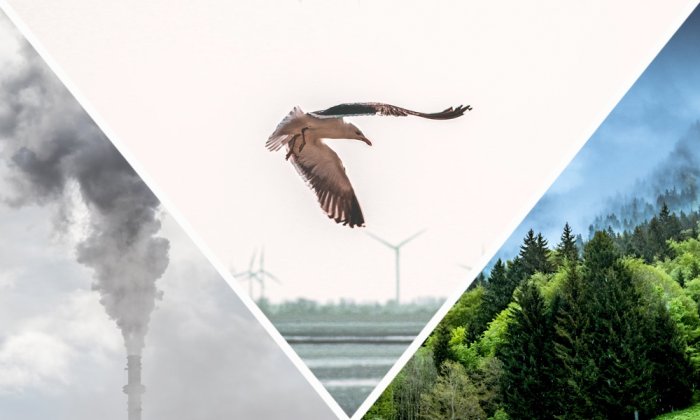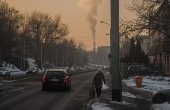Do Wind Turbines Kill Birds? (And Other Climate Questions)

There’s a lot to know about climate change — touching on Earth science, engineering, policy, economics, and more. To inform and empower the public on this urgent issue, the Massachusetts Institute of Technology (MIT) created the MIT Climate Portal, an online hub for timely, science-based information about the causes and consequences of climate change, along with its solutions. We’ve partnered with the Climate Portal to showcase some of the questions submitted to their “Ask MIT Climate” series. Here, MIT faculty and scientists lend their expertise to provide clear and informative answers about how our planet is changing, how it will impact humanity and life on Earth, and what we can do about it.
Do wind turbines kill birds?
Yes — but only a fraction as many as are killed by house cats, buildings, or even the fossil fuel operations that wind farms replace.
Wind turbines have long garnered scrutiny for killing birds that fly into their spinning blades or tall towers. Much of the data about bird deaths at wind facilities in the United States comes from studies published in 2013 and 2014. Those studies gave a wide range for the number of birds that die in wind turbine collisions each year: from 140,000 up to 679,000. The numbers are likely to be higher today, because many more wind farms have been built in the past decade.
Those numbers are not insignificant, but they represent a tiny fraction of the birds killed annually in other ways, like flying into buildings or caught by prowling house cats, which past studies have estimated kill up to 988 million and 4 billion birds each year, respectively. Other studies have shown that many more birds — between 12 and 64 million each year — are killed in the U.S. by power lines, which connect wind and other types of energy facilities to people who use the electricity.
Other sources of electricity are also more lethal for birds than wind energy. A 2012 study found that wind projects kill 0.269 birds per gigawatt-hour of electricity produced, compared to 5.18 birds killed per gigawatt-hour of electricity from fossil fuel projects. That’s in part due to collisions with equipment (wind turbines aren’t the only energy infrastructure birds can fly into), but mostly because of the environmental impact of fossil fuels. Coal mining has torn down forests and destroyed habitat, and burning coal produces air pollution tied to acid rain and mercury contamination, which scientists have linked to bird health impacts like birth defects. But when it comes to bird deaths, the most significant impact from fossil fuels is their contribution to climate change, which scientists expect will be extremely dangerous for birds. The National Audubon Society estimates that about two-thirds of bird species in North America are at increased risk of extinction due to rising temperatures and changes to the habitat where they live.
The National Audubon Society estimates that about two-thirds of bird species in North America are at increased risk of extinction.
“When assessing electricity generation technologies, it’s important to evaluate against baseline generation alternatives, because electricity generation is a requirement of modern society,” says Michael Howland, MIT professor of civil and environmental engineering. “Fossil fuels contribute to climate change, increased air pollution, and negative impacts on human and animal health, including birds, among other issues. Wind energy is an electricity generation technology that significantly reduces such environmental and health impacts.”
Still, scientists and conservationists are actively working to minimize bird interactions at wind facilities. “Environmental impact studies” are conducted before the construction of large infrastructure projects, including wind farms, and are meant to ensure projects are not sited in locations that pose a risk to protected species. Researchers are still trying to understand all of the reasons why birds may crash into turbines, such as poor visibility or migration patterns. Some conservation biologists are studying how specific species and migration routes are affected by wind facilities, and if wind farms built in certain places may have an outsized impact on vulnerable bird populations.
There are also ways to build safer wind farms for birds. Before construction, wind companies survey sites, and can place fewer turbines in areas most important for habitat, or leave those areas alone entirely. Scientists have found that painting one blade of a turbine black, which can increase visibility, can reduce bird fatalities by more than 70 percent. And some wind companies are experimenting with using artificial intelligence to sense a bird’s approach, powering turbines down to avoid collisions.
–MIT Climate Portal Writing Team, featuring guest expert Michael Howland, Esther and Harold E. Edgerton Assistant Professor of Civil and Environmental Engineering
How much human-produced carbon dioxide is taken up by faster plant growth around the world?
Close to one-third of humanity’s carbon emissions are stored on land by trees, other plants, and soil, as high CO₂ levels allow for more photosynthesis.
Plants are a natural “carbon sink”: As they grow, plants use sunlight to convert water and carbon dioxide (CO₂) into sugar, effectively storing carbon in their tissues. This process helps regulate our planet’s temperature by taking climate-warming CO₂ out of the atmosphere.
But this “land carbon sink” is actually a recent change for our planet. Before the Industrial Revolution, humans enjoyed a stable period for the Earth’s climate when plants and soils captured about as much carbon as they released. It’s the extra CO₂ in the air today — from human activities like burning fossil fuels — that has boosted the rate of photosynthesis and let plants take up more carbon, which they use to grow faster and use water more efficiently.
This is a complex process, which is also influenced by factors like deforestation and nitrogen availability, says César Terrer, an assistant professor of civil and environmental engineering at MIT who studies how plants respond to climate change. But the basic situation is clear: Research has shown that the carbon absorbed by land, including plants, has been on the rise since the 1960s.
“A little bit counterintuitive, right? To think about CO₂ doing something good,” he says.
This accelerated plant growth can be confirmed in several different ways, including through climate models, field and satellite measurements, and also by looking at isotopes in plant material, according to Terrer. Today, plants absorb between a quarter and a third of human-caused emissions per year. (The amount changes year to year based on factors like droughts and wildfires.)
When plants absorb CO₂, a portion of that carbon remains in the plants themselves, while another portion is transported to the soil plants grow in. Scientists are still working to understand how much carbon stays in plant biomass and how much is transferred to soils, as well as how climate change affects the ability of soil to store carbon.
“It is well-established that plants have been absorbing increasing amounts of carbon in their biomass,” says Terrer. “How much carbon has been sequestered in soils, if at all — that’s not well understood.”
Scientists do know that there’s only so much extra carbon plants and soils can take in.
At very high CO₂ levels, plants eventually reach a point where they can’t absorb CO₂ any faster. Atmospheric levels of CO₂ are currently below this point for most plants, but as the world continues to warm, the efficiency with which plants absorb excess carbon will rise more and more slowly.
Climate change can also hurt plants. Warmer temperatures, wildfires, more frequent and severe droughts, rising sea levels and other climate impacts can all kill plants off. And as plants die, decay or burn, they release the CO₂ they stored, reducing their ability to act as a carbon sink.
Ultimately, faster plant growth is not a silver bullet against climate change.
In some regions of the world, such as the Amazon Rainforest, this is already a pressing concern. The Amazon is starting to take in carbon more slowly thanks to deforestation, more frequent and severe droughts, and changing rainfall patterns. Some studies even suggest that, as it continues to lose trees, the Amazon is at risk of flipping from a carbon sink to a carbon source in the next decade.
Ultimately, faster plant growth is not a silver bullet against climate change. “While plants are indeed absorbing more CO₂ and buying us some time in the fight against climate change, it’s crucial to remember that they can only sequester a fraction of human emissions. Increased emissions will invariably lead to higher temperatures,” says Terrer.
“The good news is plants are providing some buffer against climate change. However, the future of this ecosystem service is highly uncertain, especially considering the complex interactions between climate factors and plant growth.”
–MIT Climate Portal Writing Team, featuring guest expert Cesar Terrer, assistant professor of civil and environmental engineering
How much is captured CO₂ worth?
Facilities using carbon capture usually can’t sell large amounts of CO₂ in commercial markets — but in the U.S., thanks to tax credits, they can get $85 a ton for burying it.
“Carbon capture” technologies are used to separate carbon dioxide (CO₂) from other gases — usually in the waste streams of power plants and industrial facilities that burn fossil fuels. In this way, the CO₂ is kept out of the atmosphere, where it would contribute to climate change.
But carbon capture operations need something to do with all the CO₂ they’re keeping out of the air. There are a few commercial markets for captured CO₂, such as in carbonated beverages or greenhouses that use piped-in CO₂ to grow plants. And there are other, more speculative proposals to transform CO₂ into valuable products like plastics and fuel. But “utilization is very challenging,” says Howard Herzog, a Senior Research Engineer in the MIT Energy Initiative who has been working with carbon capture for over 30 years.
One problem, according to Herzog, is that “markets for CO₂ are generally much smaller than the amount of CO₂ we put out there.” Greenhouses and soda companies only need so much CO₂, and if carbon capture grows enough to make a serious dent in climate change, it will quickly outstrip these markets.
It can also be hard to sell captured CO₂ since these markets can get carbon from other, often cheaper sources. For instance, the CO₂ pumped into greenhouses frequently comes from burning fuels like natural gas, while high-purity CO₂ can be sourced from ammonia production in fertilizer plants, where it’s captured as part of normal operations and doesn’t need special carbon capturing technology.
Another issue is that many of the potential uses for CO₂ undermine the climate benefits of capturing it in the first place. “If you’re capturing CO₂ for climate reasons and you put it into soda pop, when people drink the soda pop it goes back into the atmosphere,” explains Herzog. “So you haven’t done anything in terms of reducing carbon emissions.” Meanwhile, converting captured carbon into a plastic or a fuel requires a lot of energy, and most of that energy isn’t clean. “Until we have enough low carbon energy to do that, it’s not going to make sense.”
If the commercial markets can’t absorb all the carbon we want to capture for climate reasons, what happens to all the excess captured CO₂? Luckily, governments can step in to make carbon capture more profitable even if the free market doesn’t. Herzog explains that thanks to a federal tax credit known as 45Q, companies that capture carbon in the U.S. are probably getting better economic benefits by storing it underground than selling it.
Section 45Q of the U.S. Internal Revenue Code provides a tax credit for every metric ton of CO₂ that’s captured and stored. Section 45Q was first introduced in 2008, and the amount paid for captured CO₂ increased after the passage of the Inflation Reduction Act in August 2022.
How much you get paid depends on what you do with the captured CO₂, explains Herzog. It can either be injected and stored in underground geological formations, or used in enhanced oil recovery (EOR), where it’s pumped into oil reserves to squeeze more oil out. “You get 85 dollars a ton if you put it in a geologic formation and 60 dollars a ton if you use it for enhanced oil recovery.”
“If we’re going to do this on the billion ton a year level, most of it’s going to have to go into the ground.”
There’s also a special price for CO₂ pulled directly from the atmosphere — a much more expensive process than capturing carbon from a smokestack. For CO₂ captured via “direct air capture,” Section 45Q pays $180 for every ton stored in the ground and $130 when it’s used for EOR.
Section 45Q isn’t just putting a price on every ton of carbon that’s captured and stored; it’s giving the carbon capture industry a boost in other ways. When the Inflation Reduction Act passed last year, it made it easier for new carbon capture facilities to be eligible for the 45Q tax credits by, for instance, extending to 2033 when new facilities need to begin construction to be eligible.
The landscape for selling captured carbon to commercial markets may change in the future, but not in the near future, says Herzog. The amount of CO₂ we can use is simply dwarfed by the CO₂ that needs to be captured for climate reasons. In Herzog’s opinion, “if we’re going to do this on the billion ton a year level, most of it’s going to have to go into the ground.”
–Fernanda Ferreira, MIT Climate Portal Writing Team, featuring guest expert Howard Herzog, Senior Research Engineer at the MIT Energy Initiative and author of “Carbon Capture.”
To get new questions and answers monthly in your inbox, sign up for the MIT Climate newsletter.



